#$0.36
Photo

Fruition
Come to these woods and suffer no pain; you've burdens to lose and new life to gain.
Artist: Steve Luke
TCG Player Link
Scryfall Link
EDHREC Link
18 notes
·
View notes
Text
oh i see, opening sechan verse + singing to weed out the weak ones
1 note
·
View note
Text
Artur Żmijewski - Singing Lesson 1 (1/2 due to video length limit, 2/2)
2001 (betacam, running time: 14 min.)
Alumni of the Deaf-Mute Institute in Warsaw perform Kyrie from Jan Maklakiewicz’s Polish Mess.
#artur zmijewski#singing lesson#contemporary art#got absolutely mesmerized by this last week#nan#video#conductors smile at -0.36 makes me wanna rewatch the young pope lmao
1 note
·
View note
Text
“Humans in the loop” must detect the hardest-to-spot errors, at superhuman speed

I'm touring my new, nationally bestselling novel The Bezzle! Catch me SATURDAY (Apr 27) in MARIN COUNTY, then Winnipeg (May 2), Calgary (May 3), Vancouver (May 4), and beyond!

If AI has a future (a big if), it will have to be economically viable. An industry can't spend 1,700% more on Nvidia chips than it earns indefinitely – not even with Nvidia being a principle investor in its largest customers:
https://news.ycombinator.com/item?id=39883571
A company that pays 0.36-1 cents/query for electricity and (scarce, fresh) water can't indefinitely give those queries away by the millions to people who are expected to revise those queries dozens of times before eliciting the perfect botshit rendition of "instructions for removing a grilled cheese sandwich from a VCR in the style of the King James Bible":
https://www.semianalysis.com/p/the-inference-cost-of-search-disruption
Eventually, the industry will have to uncover some mix of applications that will cover its operating costs, if only to keep the lights on in the face of investor disillusionment (this isn't optional – investor disillusionment is an inevitable part of every bubble).
Now, there are lots of low-stakes applications for AI that can run just fine on the current AI technology, despite its many – and seemingly inescapable - errors ("hallucinations"). People who use AI to generate illustrations of their D&D characters engaged in epic adventures from their previous gaming session don't care about the odd extra finger. If the chatbot powering a tourist's automatic text-to-translation-to-speech phone tool gets a few words wrong, it's still much better than the alternative of speaking slowly and loudly in your own language while making emphatic hand-gestures.
There are lots of these applications, and many of the people who benefit from them would doubtless pay something for them. The problem – from an AI company's perspective – is that these aren't just low-stakes, they're also low-value. Their users would pay something for them, but not very much.
For AI to keep its servers on through the coming trough of disillusionment, it will have to locate high-value applications, too. Economically speaking, the function of low-value applications is to soak up excess capacity and produce value at the margins after the high-value applications pay the bills. Low-value applications are a side-dish, like the coach seats on an airplane whose total operating expenses are paid by the business class passengers up front. Without the principle income from high-value applications, the servers shut down, and the low-value applications disappear:
https://locusmag.com/2023/12/commentary-cory-doctorow-what-kind-of-bubble-is-ai/
Now, there are lots of high-value applications the AI industry has identified for its products. Broadly speaking, these high-value applications share the same problem: they are all high-stakes, which means they are very sensitive to errors. Mistakes made by apps that produce code, drive cars, or identify cancerous masses on chest X-rays are extremely consequential.
Some businesses may be insensitive to those consequences. Air Canada replaced its human customer service staff with chatbots that just lied to passengers, stealing hundreds of dollars from them in the process. But the process for getting your money back after you are defrauded by Air Canada's chatbot is so onerous that only one passenger has bothered to go through it, spending ten weeks exhausting all of Air Canada's internal review mechanisms before fighting his case for weeks more at the regulator:
https://bc.ctvnews.ca/air-canada-s-chatbot-gave-a-b-c-man-the-wrong-information-now-the-airline-has-to-pay-for-the-mistake-1.6769454
There's never just one ant. If this guy was defrauded by an AC chatbot, so were hundreds or thousands of other fliers. Air Canada doesn't have to pay them back. Air Canada is tacitly asserting that, as the country's flagship carrier and near-monopolist, it is too big to fail and too big to jail, which means it's too big to care.
Air Canada shows that for some business customers, AI doesn't need to be able to do a worker's job in order to be a smart purchase: a chatbot can replace a worker, fail to their worker's job, and still save the company money on balance.
I can't predict whether the world's sociopathic monopolists are numerous and powerful enough to keep the lights on for AI companies through leases for automation systems that let them commit consequence-free free fraud by replacing workers with chatbots that serve as moral crumple-zones for furious customers:
https://www.sciencedirect.com/science/article/abs/pii/S0747563219304029
But even stipulating that this is sufficient, it's intrinsically unstable. Anything that can't go on forever eventually stops, and the mass replacement of humans with high-speed fraud software seems likely to stoke the already blazing furnace of modern antitrust:
https://www.eff.org/de/deeplinks/2021/08/party-its-1979-og-antitrust-back-baby
Of course, the AI companies have their own answer to this conundrum. A high-stakes/high-value customer can still fire workers and replace them with AI – they just need to hire fewer, cheaper workers to supervise the AI and monitor it for "hallucinations." This is called the "human in the loop" solution.
The human in the loop story has some glaring holes. From a worker's perspective, serving as the human in the loop in a scheme that cuts wage bills through AI is a nightmare – the worst possible kind of automation.
Let's pause for a little detour through automation theory here. Automation can augment a worker. We can call this a "centaur" – the worker offloads a repetitive task, or one that requires a high degree of vigilance, or (worst of all) both. They're a human head on a robot body (hence "centaur"). Think of the sensor/vision system in your car that beeps if you activate your turn-signal while a car is in your blind spot. You're in charge, but you're getting a second opinion from the robot.
Likewise, consider an AI tool that double-checks a radiologist's diagnosis of your chest X-ray and suggests a second look when its assessment doesn't match the radiologist's. Again, the human is in charge, but the robot is serving as a backstop and helpmeet, using its inexhaustible robotic vigilance to augment human skill.
That's centaurs. They're the good automation. Then there's the bad automation: the reverse-centaur, when the human is used to augment the robot.
Amazon warehouse pickers stand in one place while robotic shelving units trundle up to them at speed; then, the haptic bracelets shackled around their wrists buzz at them, directing them pick up specific items and move them to a basket, while a third automation system penalizes them for taking toilet breaks or even just walking around and shaking out their limbs to avoid a repetitive strain injury. This is a robotic head using a human body – and destroying it in the process.
An AI-assisted radiologist processes fewer chest X-rays every day, costing their employer more, on top of the cost of the AI. That's not what AI companies are selling. They're offering hospitals the power to create reverse centaurs: radiologist-assisted AIs. That's what "human in the loop" means.
This is a problem for workers, but it's also a problem for their bosses (assuming those bosses actually care about correcting AI hallucinations, rather than providing a figleaf that lets them commit fraud or kill people and shift the blame to an unpunishable AI).
Humans are good at a lot of things, but they're not good at eternal, perfect vigilance. Writing code is hard, but performing code-review (where you check someone else's code for errors) is much harder – and it gets even harder if the code you're reviewing is usually fine, because this requires that you maintain your vigilance for something that only occurs at rare and unpredictable intervals:
https://twitter.com/qntm/status/1773779967521780169
But for a coding shop to make the cost of an AI pencil out, the human in the loop needs to be able to process a lot of AI-generated code. Replacing a human with an AI doesn't produce any savings if you need to hire two more humans to take turns doing close reads of the AI's code.
This is the fatal flaw in robo-taxi schemes. The "human in the loop" who is supposed to keep the murderbot from smashing into other cars, steering into oncoming traffic, or running down pedestrians isn't a driver, they're a driving instructor. This is a much harder job than being a driver, even when the student driver you're monitoring is a human, making human mistakes at human speed. It's even harder when the student driver is a robot, making errors at computer speed:
https://pluralistic.net/2024/04/01/human-in-the-loop/#monkey-in-the-middle
This is why the doomed robo-taxi company Cruise had to deploy 1.5 skilled, high-paid human monitors to oversee each of its murderbots, while traditional taxis operate at a fraction of the cost with a single, precaratized, low-paid human driver:
https://pluralistic.net/2024/01/11/robots-stole-my-jerb/#computer-says-no
The vigilance problem is pretty fatal for the human-in-the-loop gambit, but there's another problem that is, if anything, even more fatal: the kinds of errors that AIs make.
Foundationally, AI is applied statistics. An AI company trains its AI by feeding it a lot of data about the real world. The program processes this data, looking for statistical correlations in that data, and makes a model of the world based on those correlations. A chatbot is a next-word-guessing program, and an AI "art" generator is a next-pixel-guessing program. They're drawing on billions of documents to find the most statistically likely way of finishing a sentence or a line of pixels in a bitmap:
https://dl.acm.org/doi/10.1145/3442188.3445922
This means that AI doesn't just make errors – it makes subtle errors, the kinds of errors that are the hardest for a human in the loop to spot, because they are the most statistically probable ways of being wrong. Sure, we notice the gross errors in AI output, like confidently claiming that a living human is dead:
https://www.tomsguide.com/opinion/according-to-chatgpt-im-dead
But the most common errors that AIs make are the ones we don't notice, because they're perfectly camouflaged as the truth. Think of the recurring AI programming error that inserts a call to a nonexistent library called "huggingface-cli," which is what the library would be called if developers reliably followed naming conventions. But due to a human inconsistency, the real library has a slightly different name. The fact that AIs repeatedly inserted references to the nonexistent library opened up a vulnerability – a security researcher created a (inert) malicious library with that name and tricked numerous companies into compiling it into their code because their human reviewers missed the chatbot's (statistically indistinguishable from the the truth) lie:
https://www.theregister.com/2024/03/28/ai_bots_hallucinate_software_packages/
For a driving instructor or a code reviewer overseeing a human subject, the majority of errors are comparatively easy to spot, because they're the kinds of errors that lead to inconsistent library naming – places where a human behaved erratically or irregularly. But when reality is irregular or erratic, the AI will make errors by presuming that things are statistically normal.
These are the hardest kinds of errors to spot. They couldn't be harder for a human to detect if they were specifically designed to go undetected. The human in the loop isn't just being asked to spot mistakes – they're being actively deceived. The AI isn't merely wrong, it's constructing a subtle "what's wrong with this picture"-style puzzle. Not just one such puzzle, either: millions of them, at speed, which must be solved by the human in the loop, who must remain perfectly vigilant for things that are, by definition, almost totally unnoticeable.
This is a special new torment for reverse centaurs – and a significant problem for AI companies hoping to accumulate and keep enough high-value, high-stakes customers on their books to weather the coming trough of disillusionment.
This is pretty grim, but it gets grimmer. AI companies have argued that they have a third line of business, a way to make money for their customers beyond automation's gifts to their payrolls: they claim that they can perform difficult scientific tasks at superhuman speed, producing billion-dollar insights (new materials, new drugs, new proteins) at unimaginable speed.
However, these claims – credulously amplified by the non-technical press – keep on shattering when they are tested by experts who understand the esoteric domains in which AI is said to have an unbeatable advantage. For example, Google claimed that its Deepmind AI had discovered "millions of new materials," "equivalent to nearly 800 years’ worth of knowledge," constituting "an order-of-magnitude expansion in stable materials known to humanity":
https://deepmind.google/discover/blog/millions-of-new-materials-discovered-with-deep-learning/
It was a hoax. When independent material scientists reviewed representative samples of these "new materials," they concluded that "no new materials have been discovered" and that not one of these materials was "credible, useful and novel":
https://www.404media.co/google-says-it-discovered-millions-of-new-materials-with-ai-human-researchers/
As Brian Merchant writes, AI claims are eerily similar to "smoke and mirrors" – the dazzling reality-distortion field thrown up by 17th century magic lantern technology, which millions of people ascribed wild capabilities to, thanks to the outlandish claims of the technology's promoters:
https://www.bloodinthemachine.com/p/ai-really-is-smoke-and-mirrors
The fact that we have a four-hundred-year-old name for this phenomenon, and yet we're still falling prey to it is frankly a little depressing. And, unlucky for us, it turns out that AI therapybots can't help us with this – rather, they're apt to literally convince us to kill ourselves:
https://www.vice.com/en/article/pkadgm/man-dies-by-suicide-after-talking-with-ai-chatbot-widow-says

If you'd like an essay-formatted version of this post to read or share, here's a link to it on pluralistic.net, my surveillance-free, ad-free, tracker-free blog:
https://pluralistic.net/2024/04/23/maximal-plausibility/#reverse-centaurs

Image:
Cryteria (modified)
https://commons.wikimedia.org/wiki/File:HAL9000.svg
CC BY 3.0
https://creativecommons.org/licenses/by/3.0/deed.en
#pluralistic#ai#automation#humans in the loop#centaurs#reverse centaurs#labor#ai safety#sanity checks#spot the mistake#code review#driving instructor
733 notes
·
View notes
Text
SNOOZE — oscar piastri
summary. in which, everyone finally meets oscar’s new girlfriend—who happens to be a ballerina. (part three)
genre. smau
previous ↺ next


you — 2min ago
the queen has arriveeeeeed
come get your queen pls
oscar baby — 1min ago
😂😂
Finally you’re here
Your plane took his sweet time
I was ready to join you in the sky bro
you — 0.59s ago
LMAOO WHAT
stop being obsessed with me 🙄
im collecting the luggage !!!!!!!!!
oscar baby — 0.53s ago
Be careful pls
I hate the fact that I couldn’t come pick you up at airport
Lando and I tried to convince them but we kind of failed
you — 0.45s ago
dw the other man of my life is coming to pick me up
oscar baby — 0.36s ago
I’m the only man of your life
Stop tripping
you — 0.32s ago
you’re spending too much time w lando
you start speaking like him
give me my sweet oscar back ☹️☹️☹️☹️
oscar baby — 0.28s ago
I’m still sweet my love
I got you a surprise
you — 0.25s ago
REALLY ????????????????
i think i’m in love w you
oscar baby — 0.21s ago
I think too
You’re good ?
you — 0.19s ago
uuuuh ill be good if random people weren’t trying to get pictures of me
like
for what ????
WAIT BRUH
SOME RANDOM GIRL IS NOT EVEN HIDING HERSELF SHES LITERALLY TAKING PICTURES OF MY BIG ASS FACE ????????????
ok i literally ran away
oscar baby — 0.15s ago
Wtf ? What are they doing ?
This is starting to get on my nerves
Why did I even asked the staff for permission, I should’ve picked you up that’s all
you — 0.12s ago
no no no
im good baby don’t worry about me
people are weird everyday !!!!!
oscar baby — 0.9s ago
That’s not helping but okay baby
Please just get to [Your best friend’s name]’s car safely
you — 0.7s ago
dw im already outside the airport
oh
wait
do you think there is a celebrity or something that is coming out the airport ????
bc there’s literally tons of paparazzi out there
um wait a damn second
WHY R THEY SCREAMING MY NAME WTF IM NOT SELENA GOMEZ
oscar baby — 0.6s ago
Oh shit





liked by lilymhe, danielricciardo and many others…
yourusername (if we ignore the fact that my big ass face is trending on twitter) im happy to be home 🤍
view all the comments
oscarpiastri And by home, she means me
yourusername obviously 🙄
landonorris can’t even breath next to oscar she’s hugging him like a koala
yourusername you see him everyday bro don’t get on my nerves
landonorris you scare me so yes
user THE PAPARAZZI PICS PLS ☠️☠️☠️☠️☠️
user you literally flipped them off 😂😂😂
yourusername they were starting to get on my nerves bruh
user queen
user omg finally the return of yourname and oscar’s pictures 🙏🙏🙏🙏🙏🙏🙏
danielricciardo 😂😂
yourusername stop laughing
danielricciardo Ok Lord Farquaad
yourusername if we don’t fight at the next race i don’t understand
user OMG YOURNAME IS COMING TO THE NEXT RACE
landonorris LMAO I JUST SAW THE LADY’S VIDEO ON TWITTER
yourusername she literally zoomed on my pimples wtf ????????????????
lilymhe i wanna become bestie w you
yourbestfriend you’re not stealing my place ❗️❗️
lilymhe please ☹️
yourbestfriend how much would you pay
lilymhe can i pay you w food ?
yourbestfriend you BETTER pay me w food
user can we just stop and talk about the beauty of this woman
user like why are you being so gorgeous and for what reasons
liked by oscarpiastri
mclaren We missed your health walks in the paddock ! 😂🧡
yourusername i missed you too admin
oscarpiastri and yourusername posted new stories !


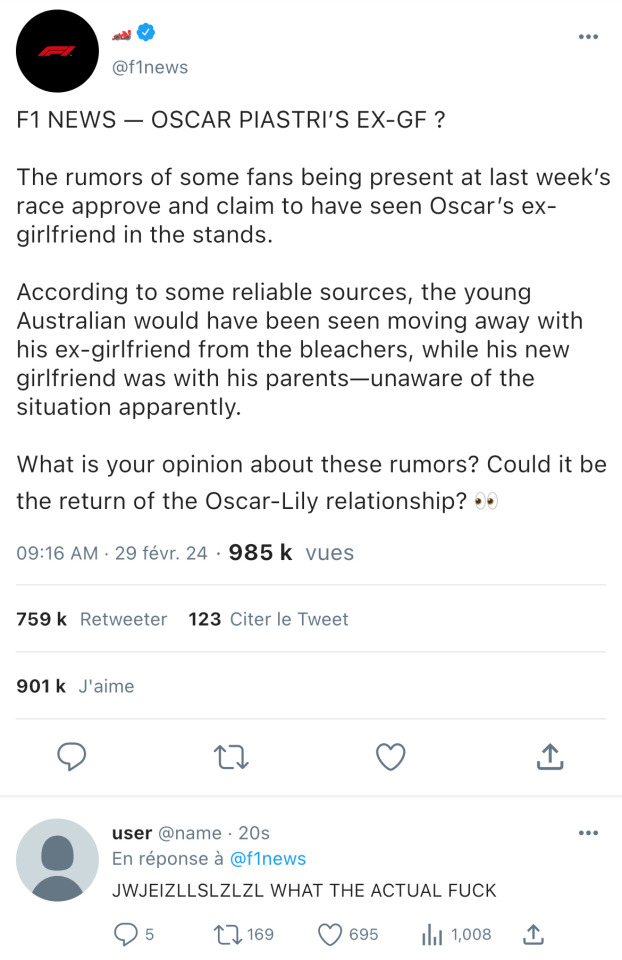


© eatingaburrito
#f1 x reader#oscar piastri fluff#oscar piastri x reader#oscar piastri smau#oscar piastri x you#oscar piastri imagine#oscar piastri#fluff#f1 smau#f1 fluff#f1 imagine#f1 fic#f1 fanfic#lando norris#daniel ricciardo#charles leclerc
766 notes
·
View notes
Text
Vani Commercial Standalone March 2022 Net Sales at Rs 0.36 crore, up 66.78% Y-o-Y
Vani Commercial Standalone March 2022 Net Sales at Rs 0.36 crore, up 66.78% Y-o-Y
Vani Commercial Standalone March 2022 Net Sales at Rs 0.36 crore, up 66.78% Y-o-Y
NULL
NULL
Go to Source

View On WordPress
0 notes
Text
“How Often Does Such a Bright Moon Come Around?” (水調歌頭 · 明月幾時有) Translation
(Another year, another Mid-Autumn Festival, another poem translation. This particular poem is very famous because of the first and last lines, which are frequently referenced in popular culture. Happy Mid-Autumn Festival!)
How often does such a bright moon come around?
By Su Shi (Song dynasty, 1076 AD)
Mid-Autumn of the year Bingchen (2), drank all night in celebration, became heavily inebriated. Composed this poem to commemorate this occasion, and in dedication to Ziyou (3). (4)
How often does such a bright moon come around? With wine in hand, I ask the heavens.
Wondering what year it is for this day in heaven (5), in the palace high above.
Wishing to ascend on the wind, yet I cannot stand the chilly air around those lofty towers of jade.
Dancing and amused at my own crisp shadow, the frigid heavens surely cannot compare to the mortal realm below.
Rounding the vermilion building, hanging low near the intricate windows, the moon casts light over the sleepless (6).
The moon should not feel bitter jealousy, so why is it only full on parting?
Humans feel grief and joy, partings and reunions, just as the moon waxes and wanes.
For both of these heartening things (7) to happen together is very rare indeed.
May we be blessed with longevity, so that even when thousands of li (8) apart, we can still gaze upon this wonderful moon together.
—————————-
Notes:
This poem is in the Ci/词 format, and follows the rhyme scheme (Cipai/词牌) called Shuidiaogetou/水調歌頭/水调歌头.
Bingchen/丙辰 is a year in the Chinese Sexagenary Cycle, which is known in Chinese as Tiangandizhi/天干地支 ("Heavenly Stems and Earthly Branches") or simply Ganzhi/干支 ("Stems and Branches"), and is used to record time. This system has been in use since at least the Shang dynasty around 3000 years ago (oracle bone artifact bearing inscriptions of ganzhi has been found at Yinxu/殷墟, the archaeological site of the ancient capital of Shang dynasty; however, during Shang dynasty the Ganzhi system was used to track days and not years, unlike how it has been used in later times). Because there are 60 years in one cycle, it is possible to trace back to specific years. In this case, Bingchen would be exactly 1076 AD.
Ziyou/子由 is the courtesy name of Su Shi's brother, Su Zhe/蘇轍.
This section is a short introduction to the poem, which begins after this section.
This may be a reference to the concept that "a day in heaven is a year on earth" ("天上一天,地上一年"; famously included in Journey to the West), which in turn is a reference to the ecliptic plane (called Huangdao/黄道 in Chinese), since for an observer on Earth, the Sun appears to move in an elliptical path throughout the year. This means that it takes a year (i.e. "a year on earth") for the Sun to "complete" one round in this elliptical path (i.e. "a day in heaven").
Here, "the sleepless" is a reference to the poet himself.
"Both of these heartening things" refers to reunion with family and/or friend, and the occurence of a full moon.
Li/里 is a traditional unit of distance. During Su Shi's time (Northern Song dynasty, 960 AD - 1279 AD), 1 Li ≈ 576 meters = 0.576 km or 0.36 miles (Note: link leads to pdf).
—————————-
Original Text (Traditional Chinese):
《 水調歌頭 (1) · 明月幾時有 》
[宋] 蘇軾
丙辰中秋,歡飲達旦,大醉,作此篇,兼懷子由。
明月幾時有?把酒問青天。不知天上宮闕,今夕是何年。
我欲乘風歸去,惟恐瓊樓玉宇,高處不勝寒。起舞弄清影,何似在人間。
轉朱閣,低綺戶,照無眠。不應有恨,何事長向別時圓?
人有悲歡離合,月有陰晴圓缺,此事古難全。但願人長久,千里共嬋娟。
#mid autumn festival#midautumnfestival#chinese poem#poetry#how often does such a bright moon come around#my translation#明月几时有#苏轼
171 notes
·
View notes
Text
Duplicate Frame Deletion: A Likely Unnecessary Tutorial
So… you updated to MacOS Sonoma, and–while it is amazing in many regards for photoshop things–it is a dang bummer and mood killer if you use MPV. However, after slamming my head into a wall trying to change the code on my own, I realized there is a much, much simpler solution to this.
In this tutorial, I will be showing you all how to delete duplicate frames from your gifs, with two options:
duplicate finder
within photoshop
Under the cut because pictures are a visual learner’s best friend!
A quick note:
MPV is odd with this. I’ve not had to do this on 4k capping, but have had to on anything under that. I don’t know the full reasoning, but it mostly looks to be something with the way it is reading frame rate. I know it’s in the code, but could not pinpoint it myself, and these were the only tricks that worked. If you find a better solution, please let me know! It has been rough, otherwise.
Step 1: Cap in MPV as normal
Now, this may be obvious, but make your caps in MPV. For a full tutorial on this, I highly recommend this one by kylos. The only difference between our software and their suggestion is going to be using the newest version of MPV (.0.36 at the time of this), and not the older. This is because there is an issue with MacOS Sonoma and older versions of MPV that prevent it from opening for… Some reason.
Step 2: Make sure you have your caps
I recommend moving your caps to whatever folder you like for your own ease of use. My biggest rec is to have it in its own folder, with no older folders within the folder. Not really a requirement, but in my mind, it makes the process faster (only true depending on number of files in other folders). You should have something like this (I am doing a scene from TWOT, as it’s one I’ve tested this method on a few times in several instances):
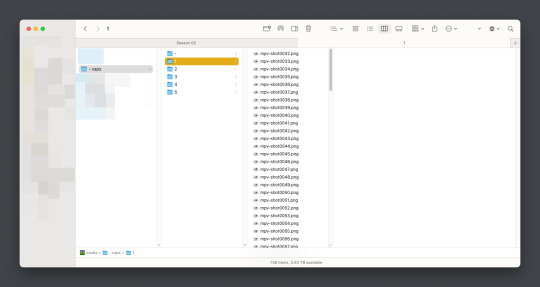
Once there, it’s time for the line split. I recommend option 1 the most (it’s faster, IMO), but again, this is a two option thing.
Option 1: Duplicate File Finder
So, duplicate finders are what they sound like. They are pieces of software that can be used to scan your device (or specific sections of said device), for duplicate files. It does not matter the title of the file, if the system reads it as a copy, it will find it.
There are a number of varieties for this, paid and free. I will not lie, the one I use is a paid version, because I had a huge issue with duplicate files taking up space when I moved to a new device. This also helps a lot with cloud file keeping, in my opinion. But that is beside the point.
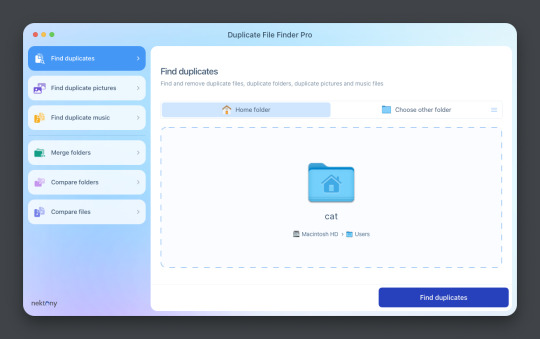
This is Duplicate File Finder Pro, which I got for other reasons, but has been very useful since this became an issue. The free version is sufficient for removing duplicate files found in folders, and that is why I still suggest it. You only need to get the pro if you have other intentions.
Now, onto the next step…
Step 3: Drag and drop the folder
With our folder full of caps, we simply drag and drop it into the application to begin.

Step 4: Click “Find duplicates” and watch the pretty graph roll.

Step 5: Select the duplicate images
You can see here it found the duplicates.

Now, I could go through by hand and click them, but… that’s a lot of time I don’t want to waste. I let it auto select them instead (you can tweak the settings for auto-select, but this is not that tutorial).
Step 6: Select review & remove, complete!
Wham bam! You’re completely set and good to go. Gif as normal~ (all final results at bottom)
Now, of course, maybe you don’t want a duplicate remover. Understandable, so what then? Well…
Option 2: Photoshop & the Changing Frame rate
So, this one is a little more technical. I suggest basic giffing and Photoshop knowledge before attempting.
Step 3: Import folder as you normally would
I believe this works as it would for import video, but I don’t want to say that and be wrong. But load your files in and you’ll be here:

Now create video timeline, make frames from layers, yada yada (kylos’ guide is very good with this if you need help, it’s the same that was linked at the beginning of this). You’ll now be here:

And the actual part of the tutorial you all came here for...
Step 4: Change the frame rate
So, in the bottom, next to the mountains for zooming in on the timeline, you’ll see it reads “30.00 fps.” We need to change this to 60. How? Easy! Click the three lines circled here:

Then click “Set Timeline Frame Rate…”

A little box will pop up, change the 30 to 15 (dropdown or typing, it works the same) and click “OK.”

Your timeline will now be cut in half for length. That’s OKAY. DO NOT PANIC.
(Optional) Step 5: Double Checking
Click play on your gif, and you’ll notice it is no longer duplicate framed! To verify, let’s convert back to frames, just to see…

And it did, success! So make the rest of your gif as normal.
Your final results for the gif will be the following, with the gifs all labeled on what option was taken (or not). These were cropped for uploading and sharpened because of how I am. No coloring applied.



If anything was confusing, please don't hesitate to reach out! I'm happy to help in any way I can on this. My ask is always open. Happy Giffing!
#alielook#singinprincess#sophiedevreaux#tuserabbie#tuserheidi#userace#userairi#useraish#userbarrow#userdorksinlove#userhella#userkayjay#userkraina#usermadita#usernik#userrobin#usershale#usersmia#usersray#usertj#c*tutorials#photoshop shenanigans
154 notes
·
View notes
Photo

Muslim population (% of their total population)
by plotset
Mauritania 🇲🇷 - 99.9%
Somalia 🇸🇴 - 99.8%
Tunisia 🇹🇳 - 99.8%
Afghanistan 🇦🇫 - 99.6%
Iran 🇮🇷 - 99.4%
Turkey 🇹🇷 - 99.2%
Yemen 🇾🇪 - 99.1%
Algeria 🇩🇿 - 99%
Morocco 🇲🇦 - 99%
Maldives 🇲🇻 - 98.4%
Niger 🇳🇪 - 98.3%
Palestine 🇵🇸 - 97.5%
Jordan 🇯🇴 - 97.2%
Saudi Arabia 🇸🇦 - 97.1%
Sudan 🇸🇩 - 97%
Libya 🇱🇾 - 97%
Azerbaijan 🇦🇿 - 96.9%
Tajikistan 🇹🇯 - 96.7%
Pakistan 🇵🇰 - 96.5%
Uzbekistan 🇺🇿 - 96.5%
Iraq 🇮🇶 - 95.7%
Syria 🇸🇾 - 93%
Egypt 🇪🇬 - 92.3%
Bangladesh 🇧🇩 - 90.4%
Indonesia 🇮🇩 - 87.2%
Kyrgyzstan 🇰🇬 - 80%
Qatar 🇶🇦 - 77%
UAE 🇦🇪 - 76%
Kuwait 🇰🇼 - 74%
Kazakhstan 🇰🇿 - 70%
Malaysia 🇲🇾 - 61%
Albania 🇦🇱 - 58%
Lebanon 🇱🇧 - 57%
Tanzania 🇹🇿 - 35%
Israel 🇮🇱 - 18%
Singapore 🇸🇬 - 14%
India 🇮🇳 - 14%
Russia 🇷🇺 - 13%
France 🇫🇷 - 8.8%
UK 🇬🇧 - 6.3%
Germany 🇩🇪 - 5.7%
Greece 🇬🇷 - 5.7%
Italy 🇮🇹 - 4.8%
Canada 🇨🇦 - 3.2%
Australia 🇦🇺 - 2.6%
USA 🇺🇲 - 1.1%
Argentina 🇦🇷 - 0.9%
Brazil 🇧🇷 - 0.36%
Japan 🇯🇵 - 0.1%
North Korea 🇰🇵 - 0.01%
Vatican City 🇻🇦 - 0%
116 notes
·
View notes
Text
Raising the Minimum Wage and Its Effects
Ko-fi prompt from [name redacted]:
So, what does raising the minimum wage really do to the rest of the economy?
Hecking Complicated! I think I might need a doc of just. References for this one. But here are a few elements!
(Also, the Congressional Budget Office has an interactive model of how different changes to the minimum wage could affect various parts of the economy, like poverty rates and overall employment. Try it out!)
Reduction of Benefits
A common claim that is used to argue against the minimum wage is that it will result in companies cutting hours for their employees in order to recoup losses by having to provide benefits to fewer employees. This isn't 'the minimum wage is bad' so much as 'corporations are assholes,' but it is unfortunately still a thing that happens. (Harvard Business Review)
This is not a problem with the minimum wage itself, in my opinion, but these issues are emblematic of the weight that self-serving elements of capitalism carry. The low minimum wage is just one part of many that contribute to the current wealth disparity; if things like health insurance were universal, then bosses wouldn't be as able to cut them to employees in order to save money. Current regulations incentivize companies to hire more part-time workers than full-time, in order to avoid paying out benefits. Some cities have enacted Fair Workweek Laws in order to combat these approaches, though the impact is as of yet uncertain (Economic Policy Institute, 2018). Early reports, like the Year Two Worker Impact Report on Seattle’s Secure Scheduling Ordinance, do seem to indicate positive results, though:
In addition, the SSO led to increases in job satisfaction and workers’ overall well-being and financial security. In particular, the Secure Scheduling Ordinance had the following impacts for Seattle workers:
- increased work schedule stability and predictability
- increased job satisfaction and satisfaction with work schedules
- increased overall happiness and sleep quality, and reduced material hardship.
(direct quote from the Year Two Eval)
Unfortunately, these were approved at the earliest in 2015 (San Francisco's Formula Retail Employee Rights Ordinances, which went into effect in March 2016), which means that none of them were in play for longer than five years before COVID-19 ground the planet's economy to a near halt. I tried to find results for the San Francisco laws, but I couldn't find any studies for it; I did find an article from March 2023 that summarized which cities in California have brought in fair workweek laws, though, so maybe someone could use that as a jumping off point (What Retailers Should Know About California Scheduling Ordinances).
Companies prevented from cutting benefits by cutting hours would probably find another way to do the same thing, but let's be real: keeping the minimum wage low won't stop them from cutting every corner possible. EPI has some articles, like "The role of local government in protecting workers’ rights," that talk about how these measures can be, and have been, implemented to protect workers from cost-cutting employers.
Cutting the hours and benefits of part-time employees is a real, genuine concern to have about raising the minimum wage, and those need to be anticipated and combated in concert with raising the minimum wage. However, it is not a reason to keep the minimum wage depressed. It's just a consequence to be aware of and plan for.
Passing Costs On To Customers
A common argument against raising the minimum wage is that companies will raise costs in order to cover the raise in expenses, to a degree that nullifies the wage hike. This is, um. Uh.
Really easily debunked?
Like, really easily.
Over a ten-plus year period, research found that a 10 percent increase in the minimum wage resulted in just a 0.36 percent increase in prices passed on to the consumer at grocery stores. A similar Seattle-based study showed that supermarket food prices were not impacted by their minimum wage increase.
- (Minimum Wage is Not Enough, Drexel U.)
I've talked about it before, but in some cases it's just a matter of how US-based labor is such a comparatively small portion of costs for medium-to-large businesses that raising wages doesn't raise corporate expenditures that much.
That said, some companies rely on drastically underpaying their employees, like Walmart. Walmart's revenue in 2020 was approximately $520 billion (Walmart Annual Report, page 29). Now, this report doesn't actually tell us what amount is spent on labor, but it does give us the "Operating, selling, general and administrative expenses, as a percentage of net sales." This is, to quote BDC, "[including] rent and utilities, marketing and advertising, sales and accounting, management and administrative salaries."
So, wages are just part of the (checks) 20.9% of revenue that is operating SG&A expenses. But maybe I'm being mean to Walmart! After all, the gross profit margin is only 24.1%, so only 3.2% is left for those poor shareholders!
Oh, oh, that means the profit is still over 16billion USD? And Walmart cites having 2.2 million associates in that same report? And that's about $7,500 per employee per year that's being withheld? And that's before we take costs up by like three cents per product?
Which, circling back: A study from Berkeley by the name of "The Pass-Through of Minimum Wages into US Retail Prices: Evidence from Supermarket Scanner Data" found that
a 10% minimum wage hike translates into a 0.36% increase in the prices of grocery products. This magnitude is consistent with a full pass-through of cost increases into consumer prices.
Of course, Walmart does sell more than just groceries, but isn't it interesting that raising a minimum wage resulted in such a small cost increase? If we assume this is linear (it's probably not, but I have so many numbers going on already), then doubling wages from 7.25 to 14.50 would still mean only a 3.6% increase costs! Your $5 gallon of milk would go up to [checks] $5.18.
Hm. Those 18 cents might be meaningful to our poorest citizens, but if those poorest citizens are more likely to be raised out of poverty by raising the minimum wage, then it might just be the case that they too can afford the new price of milk, and have more money left over for things like... rent. Or education. Or healthcare.
Maybe even a cost cutting loss leader like Walmart can reasonably increase its wages. After all, they still have 13 stores on Long Island, where the minimum wage is $15, and has been since 2021.
(I could have just cited the Berkeley study and moved on, but after a certain point I was too deep in parsing the Walmart report to not include it.)
But also... minimum wage increases are often staggered. They start out on the bigger companies, which have the resources to accommodate those changes (unless they've been doing stock buybacks), and then later on the smaller businesses, now that a portion of the economy (those working for the big companies) has the spare change to spend money at those smaller businesses that are raising their prices by a little more than the corporations.
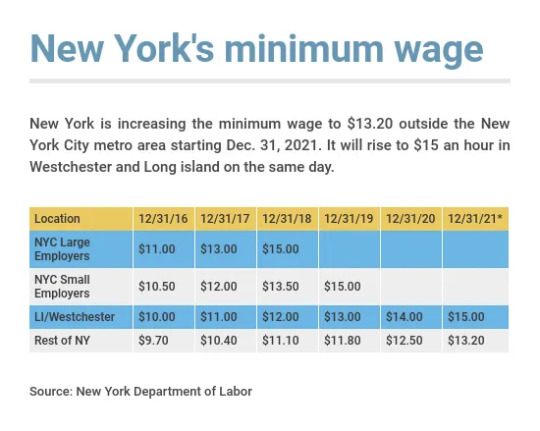
And at that point, all I can really say is, well.
If you can't afford to pay your employees a living wage, you're not an oppressed company. You're just a failing company. Sorry, Walmart&Co, your business model is predicated on fucking over poor people, and so it's a bad business model.
Being a dickhead, while successful, is not actually 'smart' business practice.
(This doesn't even get into the international impacts, like what an "American companies should pay higher wages abroad, especially if they charge higher-than-American pricing for their products, but also at factories where we know they're committing human rights abuses" approach could be but this is already long as fuck so that'll have to wait for another post.)
Anyway.
Inflation
This one is tied into the cost argument above, but like...
Inflation is already a thing? Inflation is happening whether we raise the minimum wage or not. Costs go up whether we raise the minimum wage or not. Who is this argument serving? Not the people who can't afford rent, surely.
Quoting the earlier-mentioned Drexel report (red highlights mine):
While the minimum wage has been adjusted numerous times since its implementation in 1938, it has failed to keep up with inflation and the rising cost of living. The purchasing power of minimum wage reached its peak in 1968 and steadily declined since. If it had kept up with inflation from that point it would have reached at least $10.45 in 2019. Instead, its real value continues to go down, meaning minimum wage employees are essentially being paid less each year.
Additionally, some economists argue if minimum wage increased with U.S. productivity over the years, it would be set currently at $26 per hour today and poverty rates would be close to non-existent with little negative impact on the economy. However, because gradual change was avoided, the extra funds were instead shifted to CEO compensation.
A sudden change in wages now could possibly make a more noticeable impact on the economy, which is often cited as reasoning for a slower increase over time moving forward. Gradual increases with inflation and productivity could have avoided any potential economic ripple effects from wage increases and should be considered in ongoing plans.
Increasing Unemployment
A common argument is that the unemployment rate would jump as employers were forced to let employees go. Assuming they didn't just hire more employees so they could give them less hours in order to cut benefits... not really!
A 2021 article from Berkeley News summarizes the issue, along with several others, covering some thirty years of research that started with "Minimum Wages and Employment: A Case Study of the Fast-Food Industry in New Jersey and Pennsylvania," published in 1993. They also touch on the issue of subminimum wages for tipped workers, though they do not address the subminimum wages set for underage and disabled workers.
“A minimum wage increase doesn’t kill jobs,” said Reich, chair of UC Berkeley’s Center on Wage and Employment Dynamics (CWED) . “It kills job vacancies, not jobs. The higher wage makes it easier to recruit workers and retain them. Turnover rates go down. Other research shows that those workers are likely to be a little more productive, as well.”
- Berkeley News article, "Even in small businesses, minimum wage hikes don’t cause job losses, study finds"
Lower turnover rates also save money for employers, as it causes them to have much lower HR expenses. How much money do you think large employers spend on using sites like Indeed or Glassdoor to find new employees?
This article from Richmond Fed does, admittedly, encourage a slightly grayer analysis:
In a 2021 review of some of the literature, [researchers] reported that 55.4 percent of the papers that they examined found employment effects that were negative and significant. They argued that the literature provides particularly compelling evidence for negative employment effects of an increased minimum wage for teens, young adults, the less educated, and the directly affected workers. On the other hand, in a 2021 Journal of Economic Perspectives article that analyzed the effect of the minimum wage on teens ages 16-19, Alan Manning of the London School of Economics and Political Science wrote that although the wage effect was sizable and robust, the employment effect was neither as easy to find nor consistent across estimations.
Thus, although the literature supports an effect on employment among the most affected workers, it does not appear to be as sizable as theory might suggest.
The International Labor Organization has a similarly mixed result when taking a variety of studies into account. (I left in their own reference links.)
In high-income countries, a comprehensive reviews of about 70 studies, shows that estimates range between large negative employment effects to small positive effects. But the most frequent finding is that employment effects are close to zero and too small to be observable in aggregate employment or unemployment statistics (1). Similar conclusions emerge from meta-studies (quantitative studies of studies) in the United States (2), the United Kingdom (3), and in developed economies in general (4). Other reviews conclude that employment effects are less benign and that minimum wages reduce employment opportunities for less-skilled workers (5).
And there's the 60-page "Impacts of minimum wages: review of the international evidence" from University of Massachusetts Amherst, which looks at data from both the US and UK. I'll admit I didn't read this one beyond the introduction, because this is very long already.
Not all US studies suggest small employment effects, and there are notable counter examples. However, the weight of the evidence suggests the employment effects are modest. Moreover, recent research has helped reconcile some of the divergent findings. Much of this divergence concerns how different methods handle economic shocks that affected states differently in the 1980s and early 1990s, a period with relatively little state-level variation in minimum wages.
I'd encourage you to think of it this way:
Employer A pays $7.25/hr. Employer B also pays $7.25/hr. An employee works 25hrs/week for Employer A, and 20hr/wk for Employer B.
The minimum wage goes up to $15/hr. Employer B cuts the employee. Employer A cuts employees as well, but not this one, and instead increases their hours to 30/wk for greater coverage.
The employee has gone from just under $400/wk to $450/wk. They lost a job, sure, but the end result... They have an extra fifteen hours of free time per week! Or more! With time to level out, you have less jobs, but more employment, because people aren't taking up multiple jobs (that someone else could have) just to survive.
This is a very, very simplified example, which doesn't take into account graduated wage increases (see the NYS labor table) or the benefits issue from before, but it does show the reality that "less jobs" doesn't necessarily mean "less pay" or "fewer employed" people, when so many of those employed at this pay are working multiple jobs.
Even the Washington Post agrees that the wage hike wouldn't cost as many jobs as conventional wisdom claims, and they're owned by Bezos. (Though I recognize the name of the article's author as the same person behind that 60-page Amherst report, so there's that to consider.)
The Kellogg Institute also points out that individual workers were, on average, more productive after receiving the pay increase, so the drop in the bottom line was softened. This is a bit debatable; the results varied based on the level of monitoring, but it's worth noting that most minimum wage jobs are pretty high-intensity, high-monitoring. Goodness knows you don't get a whole lot of time to yourself outside of the critical eye of your shift lead or customers if you're working fast food. They also note a decrease in profits, but I'd point out that they speak specifically of profits, not share of revenue.
To explain the difference: imagine you sell $100 of product in a day. The product cost you $50. Overhead (rent, utilities, taxes) cost you $10. Labor cost you $15. Profit, then, was $25, or $25.
A 16% reduction in the profit does not mean you now retain $11. It means that you retain 16% less of the $25. You now retain $21.
(This is, as with many of my examples, INCREDIBLY simplified, but I need to illustrate what the article's talking about, and I don't have infographics.)
Some other articles on the topic are from The Quarterly Journal of Economics, Business for a Fair Wage, The Federal Reserve Bank of San Francisco (more critical), the Center on Wage and Employment Dynamics, the Center for Economic and Policy Research, UCLA Anderson, Vox, and The Intelligencer, which cites another Berkeley article. I do not claim to have read all of these, especially the really long ones, but the links are there if you want to look into them.
In the interest of showing research from groups that do not serve my own political views, I'm going to link an article from the Cato Institute; I do encourage you to read that one with a grain of salt, given that it's written by a libertarian thinktank, and they are just as dedicated to hunting for research that serves their political views as I am. There were a few other libertarian articles I came across, but the way they presented information kept feeling really duplicitous so I just... am not linking those, or the leftist ones I am also uncomfortable with due to the whole "I'm totally not tricking you" vibes. Also eventually I just got tired, there are so many articles on this and I am just one blogger who is not actually working for a magazine or thinktank, I am working for my own personal tumblr.
Negatively Impacting Slightly-Higher Paid Employees
Did you know that raising the minimum wage affects more than just those making minimum? It affects those just above as well. It's referred to as the ripple effect of minimum wage hikes by this Brookings article. They estimate that a wage hike would affect nearly 30% of the country's workforce.
"Price adjustments provide the principal adjustment mechanism for minimum wage increases: higher labor costs are passed through to consumers, mainly for food consumed away from home. Such an increase does not deter restaurant customers. Price increases are also detectable for grocery stores (Leung 2018; Renkin, Montialoux and Siegenthaler 2019), but not more generally. The effect on inflation is therefore extremely small."
- "Likely Effects of a $15 Federal Minimum Wage by 2024," Testimony prepared for presentation at the hearing of the House Education and Labor Committee, Washington, DC (2019)
This overlaps with general criticisms of widening income equality, citing an AEA article I cannot access since it's behind a paywall. I wonder if it touches on companies like Amazon being headquartered in the city and manipulating the job market by sheer size? I can only speculate.
Plus, there are the health benefits! Which are mostly connected to lessening poverty, and through that lessening stress and increasing healthcare access, but still! Some of these results are debated, but I'd need to know more about the details to know how they're related (University of Washington).
------
I've spent most of the day on this, so if you guys have made it this far and are interested in supporting me, please donate to my ko-fi or commission an article. (Preferably for more than the base price; I'm effectively working at a fraction of minimum wage myself, which is ironic considering the theme of this post.)
(I realistically shouldn't have spent more than two or three hours on this, but I have so many strong opinions on the subject that I couldn't stop.)
(Also: There were so many more sources I didn't even get to read the basic premise of because it was so repetitive after a while.)
#economics#stock market#capitalism#phoenix talks#ko fi#ko fi prompts#minimum wage#minimum wage increase#research
202 notes
·
View notes
Photo
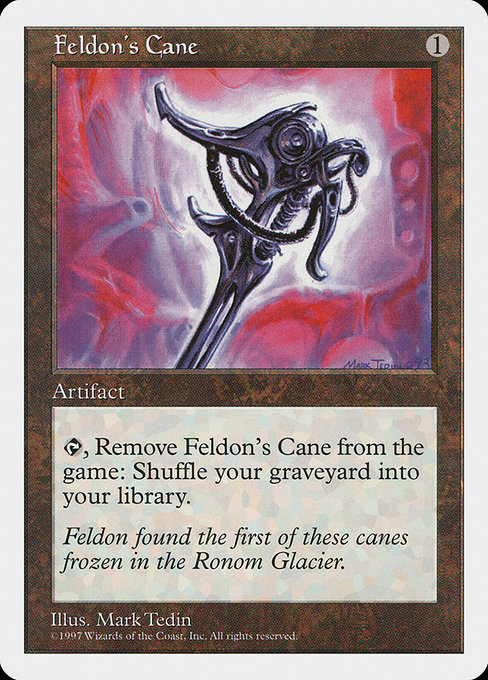
Feldon's Cane
Feldon found the first of these canes frozen in the Ronom Glacier.
Artist: Mark Tedin
TCG Player Link
Scryfall Link
EDHREC Link
43 notes
·
View notes
Text
struggling to get through school?
Hi! I feel like it's been forever since I posted something, but I'm back! Lately, I've been struggling with my ed and school, and both are affecting the other. If you're dealing with the same thing, or something similar, you're not alone. Here are some things that may help :) Also- the first one is kind of related to restrictive eds. If you're experiencing a lack of energy not having to do with your food intake, I suggest that you either see a doctor or mental health professional.
Make sure you're eating enough protein. If you're not eating enough food as it is, you may feel like you can't focus as well, or you simply don't have the energy to study, do your work, or go to school, which is understandable. But please listen to me when I say protein is extremely important. According to Harvard, to calculate how much protein you need in a day, multiply your weight (in pounds) by 0.36. Here is the link to the article, which has a calculator you can use .
If you're worried about your grades, talk to your teachers/professors. Not all professors are the same, but if you're honest with them and spell out what's been going on (as much as you're comfortable with, of course), they may be able to help you, give you an extension, or some advice on their class.
Find study techniques that work for you. Not everyone has the same learning style, and not all methods of studying will work for you. I advise that you first find out what your learning style is if you don't already know. Then, you can research what may work for you as that kind of learner. However, if you have something else going on, that may not be enough. For example, I have adhd and have a hard time getting started with my work and staying motivated. Something like getting a planner, which may work for someone else, just doesn't cut it for me. Instead, I like to use asmr pomodoros and rewards for myself when I finish a certain amount of work, like doing something I've been wanting to do or watching a movie.
If you have trouble asking for help, like I do, I know it can be scary to send an email to your teacher, ask a friend, or even raise your hand in class to ask a question. But trust me, my grades started improving as soon as I did this. I know some of you may be thinking that your teacher will judge you, or your classmates will, but teaching is their job. They want students to ask questions, that's what they're there for. Your classmates could actually be wondering the same thing, they just might be too nervous to ask.
Try your best not to procrastinate. I know, I know. But hear me out. Procrastinating causes last minute stress and most likely isn't your best work. I'm not trying to call you out, because I do this too. But as I've gotten older, and been through years of school, I've learned that I hate the looming feeling of having an assignment due the next day and not having started on it yet. Your grades will be affected by not procrastinating, as you'll have had more time to study, do your work, and go over anything you need.
If you need someone to talk to, or have any questions, please don't be scared to send me a message or an ask, I'm here to help <3
(If I think of anything else, I'll make a part 2)
#school#school tips#college tips#high school tips#studying#study tips#adhd school tips#neurodivergent school tips#neurodivergent tips#ed recovery tips#school life#study motivation#study notes#studyblr#ed support#mental heath support#mental health
182 notes
·
View notes
Text
IT IS TSUKIYAMA THURSDAY!!!

interact to be tres bien
ignore for 0.36 seconds of bad luck :v
36 notes
·
View notes
Note
si papi
bout 5,530,000 results (0.36 seconds)
😏 Smirking Face Emoji
You called me papi so hard you turned into a search engine queey response????
19 notes
·
View notes
Photo



Zombie Planets:
Draugr : PSR B1257+12 b, alternatively designated PSR B1257+12 A, also named Draugr, is an extrasolar planet approximately 2,300 light-years away[ in the constellation of Virgo. The planet is the innermost object orbiting the pulsar PSR B1257+12, making it a pulsar planet in the dead stellar system. It is about twice as massive as the Moon, and is listed as the least massive planet (with the mass accurately determined) known, including among the planets in the Solar System.
Poltergeist : PSR B1257+12 c, alternatively designated PSR B1257+12 B, also named Poltergeist, is an extrasolar planet approximately 2,300 light-years away in the constellation of Virgo. It was one of the first planets ever discovered outside the Solar System, and is one of three pulsar planets known to be orbiting the pulsar PSR B1257+12.Over four times as massive as the Earth,
it circles the primary at a distance of 0.36 AU with an orbital period of approximately 66 days. Because it and Phobetor have very similar masses and orbit close to each other, they were expected to cause measurable perturbations in each other's orbits. Detecting such perturbations confirmed that the planets were real. Accurate masses of the two planets, as well as their inclinations, were calculated from how much the planets perturb each other.
Phobetor: PSR B1257+12 C, alternatively designated PSR B1257+12 d and also named Phobetor, is a super-Earth exoplanet orbiting the pulsar PSR B1257+12 approximately 2,315 light-years (710 parsecs; 22 quadrillion kilometres) away from Earth in the constellation of Virgo. It was one of the first planets ever discovered outside the Solar System. It was discovered using the pulsar timing method, where the regular pulses of a pulsar are measured to determine if there is a planet causing variations in the data.
Source : © Wikipedia
Pictures Credit: © Melodysheep
#space#planets#earth#moon#sun#mercury#venus#mars#jupiter#saturn#neptune#SolarSystem#galaxy#Galaxies#MilkyWay#universe#zombie planets#draugr#poltergeist#phoebetor#explore#reels#follow#discover
124 notes
·
View notes
Text

Just got paid $0.36 to tell Google I'm a huge simp. Quitting my job tomorrow to do this professionally
40 notes
·
View notes